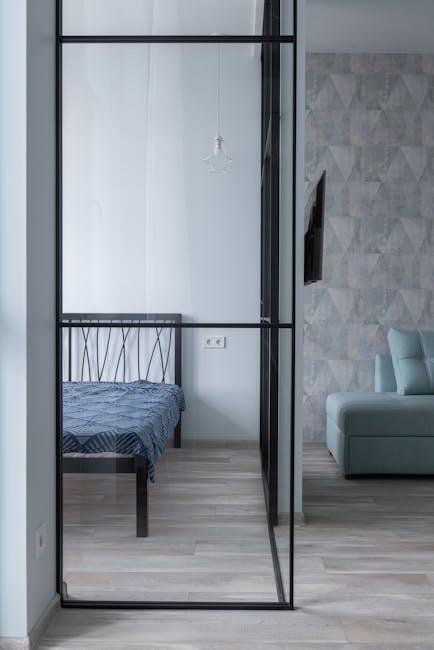introduction: The Art of Division: Embracing Fabric panels for Modern Room Dividers
In an ever-evolving world of interior design, the quest for versatile and aesthetically pleasing solutions has lead to a resurgence in the use of fabric panels as room dividers.These seamless, textile-based creations offer a unique means of demarcating spaces within a larger area, allowing for an inventive balance between openness and privacy. Weather you’re seeking to redefine a studio apartment, create a cozy nook within a shared room, or add a touch of elegance to an office environment, fabric panels serve as both functional and decorative elements. Their customizable nature caters to diverse styles and preferences, proving that separation doesn’t have to sacrifice beauty.This article delves into the myriad ways fabric panels can transform your living or working spaces, exploring their benefits, design possibilities, and practical applications, inviting you to re-imagine how you divide your world.
Exploring the Versatility of Fabric Panels in Space Division
When it comes to crafting distinct areas within a room, fabric panels stand out as a dynamic solution that marries aesthetics with functionality. These versatile dividers are not just barriers; they can be transformed into captivating design elements that enhance the overall ambiance. The benefits of using fabric panels include:
- No permanent installations: Fabric panels are lightweight and easy to move, allowing for flexibility in space arrangement.
- Sound absorption: The softness of fabric helps in reducing noise, making it ideal for shared spaces.
- Customizable options: They come in a variety of colors, patterns, and textures, enabling personalization to suit any decor.
Additionally, fabric panels can double as art pieces, making them a unique way to express creativity while maintaining practicality. With innovative mounting solutions,these panels can be used vertically or horizontally,offering more personalization in layout. To illustrate the endless possibilities, consider the following table showcasing various uses of fabric panels:
| Use Case | Benefit |
|---|---|
| Office Spaces | Enhances privacy and creates focused work zones. |
| Home Décor | Adds warmth and character to open living areas. |
| Event Planning | Defines areas while providing an elegant backdrop. |

Choosing the Right Fabric for Aesthetic Appeal and Functionality
When selecting fabric for your room divider panels, it’s crucial to strike a balance between aesthetics and functionality. The fabric you choose should complement your existing décor while providing the practical benefits you need. Consider the following factors to ensure your fabric panels not only look appealing but also enhance the usability of your space:
- Texture: Opt for textures that invite touch, such as linen or cotton, which can add warmth and coziness to the room.
- Color: Choose colors that harmonize with your interior palette; lighter shades can make space feel larger, while bold colors can act as a focal point.
- opacity: Determine the level of light filtering required—sheer fabrics create an airy feel, while thicker materials offer privacy.
- Durability: Consider the wear and tear of the fabric in high-traffic areas. Synthetic blends might be more suitable for longevity.
Additionally, the maintenance of the fabric is a key consideration. Fabrics that can be easily cleaned, such as those treated for stain resistance, maintain their appearance with minimal effort. Here’s a simple comparison of common fabric options for room dividers:
| Fabric Type | Aesthetic Appeal | Functionality | Maintenance |
|---|---|---|---|
| Linen | natural look, airy | Moderate durability | Dry clean recommended |
| Cotton | Inviting, versatile | Good durability | Machine washable |
| Polyester | Vibrant, easy to print on | high durability | Spot clean easily |
| Silk | Luxurious, soft | Low durability | Dry clean only |

Innovative Design Ideas for Seamless Integration
Fabric panels as room dividers present an opportunity to enhance both functionality and aesthetics within your space. These versatile elements can be tailored to fit any style, allowing for a harmonious blend of creativity and practicality. By choosing fabrics that complement or contrast your existing decor, you can create distinct zones within a room without sacrificing an open, airy feel. Consider the following benefits:
- Sound Absorption: Fabric panels can effectively dampen noise, making them ideal for shared spaces.
- Light Filtering: Translucent materials allow natural light to flow while providing a degree of privacy.
- Easy Customization: They can be changed or removed according to your preferences, refreshing the look of your home.
In terms of installation, options range from freestanding frames to ceiling-mounted tracks, ensuring that your design vision is realized with ease. For a cohesive look, consider incorporating patterns or colors that echo throughout your interior design elements. Here’s a simple overview of installation options:
| Type | Description | Best Use |
|---|---|---|
| Freestanding | Panels that do not require any structural support, easily movable. | Flexible spaces or temporary setups. |
| Ceiling-mounted | Suspended panels providing a more permanent solution. | Defined spaces in open floor plans. |

Tips for Installation and Maintenance of fabric Room Dividers
When installing fabric room dividers, it’s essential to ensure you have the right tools and materials on hand. Start by measuring your space accurately to determine the appropriate size for the panels. Choose a stylish and durable fabric that complements your interior. For hanging, consider using a tension rod or ceiling tracks which provide a clean and modern look. Make sure to:
- Use quality hardware that supports the weight of the fabric.
- Securely fasten the dividers to prevent sagging or movement.
- Utilize hooks or clips that match your decor style.
Maintenance of your fabric dividers is crucial for longevity and aesthetic appeal. Regularly inspect the panels for any signs of wear or damage, addressing issues promptly to prevent larger problems. Cleaning is key; depending on the fabric type, gentle washing or spot cleaning may be required. Keep in mind:
- Always refer to the manufacturer’s instructions for care.
- Avoid harsh chemicals that could damage the fabric.
- Store panels in a dry place during long-term disuse to prevent mildew.
The Conclusion
In a world where open spaces are increasingly prized, the need for versatile and aesthetically pleasing solutions has never been greater. Fabric panels emerge as a creative answer, offering both functionality and flair. Whether you’re carving out a cozy nook in a bustling studio or enhancing privacy in a shared workspace, these dividers provide not just separation but also an opportunity for expression. With countless designs, textures, and colors available, the use of fabric panels allows for personalization, transforming your space into a reflection of your unique style.As we embrace the evolving dynamics of our living and working environments, fabric panels stand out as not just a design choice, but a thoughtful response to our need for adaptability and comfort. so,the next time you’re contemplating how to optimize your space,remember that a simple change might bring harmony,beauty,and a touch of creativity to your surroundings.

